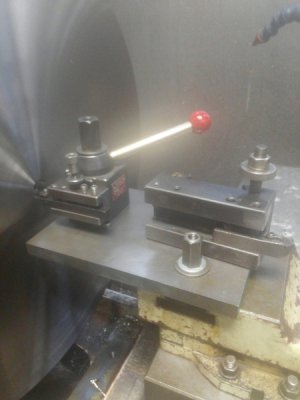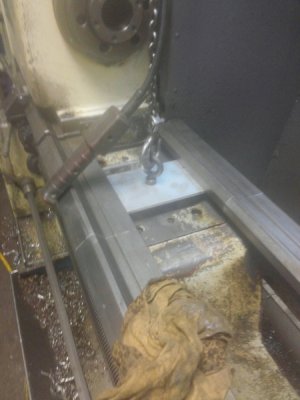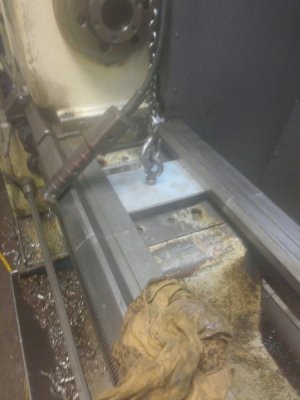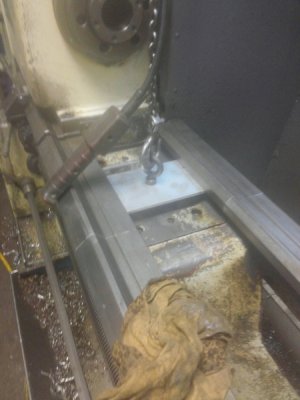-
Welcome back Guest! Did you know you can mentor other members here at H-M? If not, please check out our Relaunch of Hobby Machinist Mentoring Program!
You are using an out of date browser. It may not display this or other websites correctly.
You should upgrade or use an alternative browser.
You should upgrade or use an alternative browser.
- Joined
- Sep 19, 2012
- Messages
- 3,063
Its not me that has the social problem................. Its everyone else! 
Sent from somewhere in East Texas Jake Parker
Sent from somewhere in East Texas Jake Parker
- Joined
- Sep 29, 2014
- Messages
- 2,102
This did not work well at all, much chatter ensued as I had expected, not enough mass. I ended up milling an extension for the tool from bar and holding it in the large tool post, this approach worked reasonably well, not ideal however.
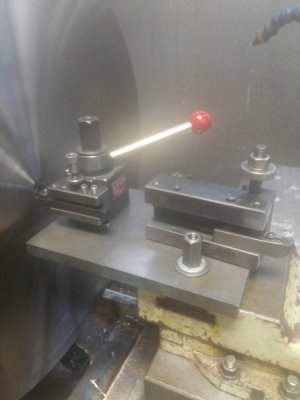
I did turn about 40 Lb's of this part into chips today so I have that going for me I suppose.

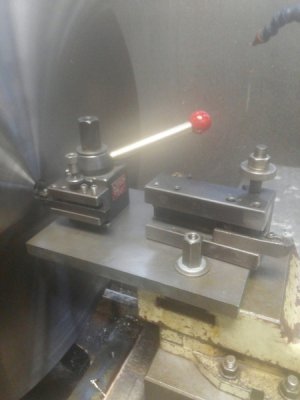

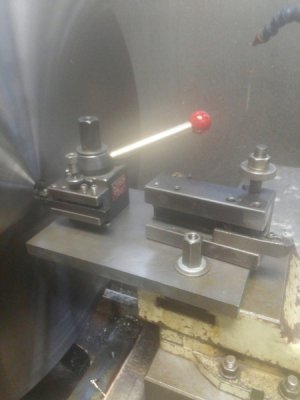


I did turn about 40 Lb's of this part into chips today so I have that going for me I suppose.





What is the outside diameter of the part? Nice extension plate you madeThis did not work well at all, much chatter ensued as I had expected, not enough mass. I ended up milling an extension for the tool from bar and holding it in the large tool post, this approach worked reasonably well, not ideal however.
I did turn about 40 Lb's of this part into chips today so I have that going for me I suppose.

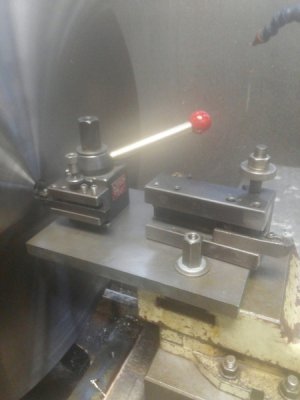

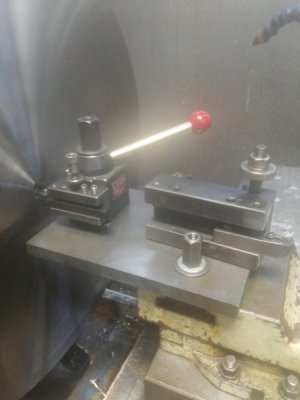

- Joined
- Sep 29, 2014
- Messages
- 2,102
27.500 ± .010 is specified on the drawing, no temperature at which it will be measured is given so one must assume ISO.What is the outside diameter of the part? Nice extension plate you made
27.500 ± .010 is specified on the drawing, no temperature at which it will be measured is given so one must assume ISO.
The last time I turn something that big were seam welder wheels in my Apprentice Training shop. We had standing orders to reface large diameter copper rings by removing the welding pits and recutting all the angles.
Thanks for the reply,
- Joined
- Sep 29, 2014
- Messages
- 2,102
Did some redneck chip management today, facing at .050 depth at 14 RPM's and .006 feed per revolution, from 28" diameter to 5", 130 minutes per pass for 3 passes.
The chip would wrap in a tight wad around the boring bar requiring constant attention so I clamped a piece of aluminum tubing under the tool block and carefully guided the tightly coiled chip into it. The chip came off of the tool and went through the tube where I would cut it with sheet metal shears, this worked a charm for the most part.
The reason that I used a boring bar for a facing operation is that once the gap is removed one does not want to run the carriage off of the end of the ways so you have to extend the tools across the gap, the gap is 18+ inches on this lathe
The chips pretty much won the day however. The lathe work on this one part is done after slightly over 25 hours of my time including set up, removing the gap, changing chucks, making and turning soft jaws Etc.
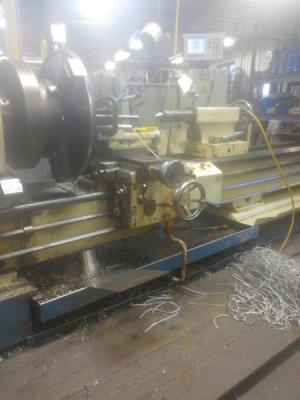
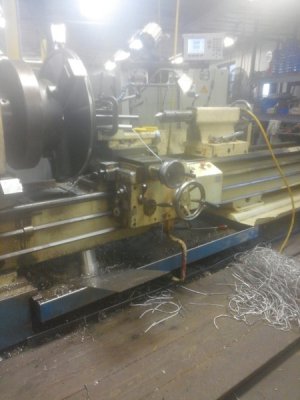
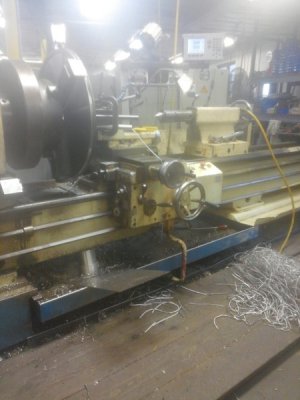
The chip would wrap in a tight wad around the boring bar requiring constant attention so I clamped a piece of aluminum tubing under the tool block and carefully guided the tightly coiled chip into it. The chip came off of the tool and went through the tube where I would cut it with sheet metal shears, this worked a charm for the most part.
The reason that I used a boring bar for a facing operation is that once the gap is removed one does not want to run the carriage off of the end of the ways so you have to extend the tools across the gap, the gap is 18+ inches on this lathe
The chips pretty much won the day however. The lathe work on this one part is done after slightly over 25 hours of my time including set up, removing the gap, changing chucks, making and turning soft jaws Etc.



- Joined
- Sep 29, 2014
- Messages
- 2,102
- Joined
- Apr 21, 2015
- Messages
- 894
I haven't read this entire thread yet, but I wanted to add my take on this elsewhere. I have this sort of instinct in business. I have gone to work for a company and within 2-3 days recognized their precise financial situation, the chief constraint to greater profits, and an outline of a solution. In one particular example my solution required a couple weeks of meetings, coordination, and programming from a team of six people in different departments. Only purchase was a software license upgrade to allow it to run on a web server instead of just a desktop. It was under $100. When we were done product turnaround time went from an unpredictable 1-6 months down to a consistent 48 hours. Saved almost a quarter million dollars in direct labor annually. No one could compete, so the marketing value was incalculable.Think of it like this:
You are called to a repair. Is the first person you talk to the supervisor? No it's not, what does he know. How about the set up person? Again no, they only know the repair is out of their job description. You go to the operator, why you ask, because he or she was the last one to see things in motion. You ask them what happened. Now you listen to them. They say there was a plinking sound then a loud bang and the machine stopped dead. You ask where in general the plinking, not the bang came from. They say from the gear end of the machine. You concentrate your efforts there. You see nothing so you go deeper into the machine. You take the first gear off and low and behold a tooth or two is missing from the gear behind it. Some machinists would stop here and change the gear to get the machine running again. OK done deal we have the machine running again. Everyone is happy.
Wrong ---The seat of the pants machinist know something else broke the gear. What was it. Instinct takes over here. Let the machine run or go deeper. He listens, something does not sound correct. He has heard this before. He remembers what it was and instinctively goes there. Found it he says. We fix this and we are good to go.
The broken gear was the end of the problem, not the root of it. Get to the root and the problem now has the correct solution. Instinct is not taught. It's either there or it's not. Brooks you can come work for me anytime.
The title Seat of the Pants Machinist", is earned. Your peers give it to you. They know the difference. Too many give titles to themselves.
"Billy G"
After I got their attention with that solution I mentioned my concern that they were running out of money and about to lay people off. The two owners looked horrified, like I was some sort of spy. How could I know such things that hadn't been made public? I explained the handful of unmistakable symptoms that were clear to anyone who knew what to look for. I explained that even a single layoff would have a devastating effect. I explained that I had an alternative that would not only avoid the layoffs but also result in entire new channels of revenue.
They responded that they had already signed with a venture capitalist who insisted on layoffs as part of his plan. Sixty of the hundred employees were cut in the next week, myself included. They did it by rolling back according to hire date "to be fair". Nothing to do with competence or contribution. So stupid.
The one owner had a favorite, moronic saying: "I don't want problem finders, I want solution builders." He's the kind of guy who would always stop at fixing the broken gear (if he had a clue what gears were...), without the slightest thought about what broke the gear.
You cannot actually solve a problem without being certain you've found the actual problem.
I know you'll be shocked to hear that almost a decade later that company still hasn't even made the slightest move into the HUGE market I had identified for them. They didn't even think to hear my idea before "letting me go."
- Joined
- Jan 28, 2011
- Messages
- 3,584
I had the best compliment the other day from the production manager. When/if I leave the company, he will be the guy right behind me. He knows that a major cog in the machine will be gone and who knows what will happen next.
Like Bill says instinct can be critical, some have it and some don't. I am always busy between improving processes, running machines, fixing them, design work and pre planning. I try to train but they can not keep up, especially when the shop is running at 100%. It is tough to set aside time and resources to teach on the job.
Pierre
Like Bill says instinct can be critical, some have it and some don't. I am always busy between improving processes, running machines, fixing them, design work and pre planning. I try to train but they can not keep up, especially when the shop is running at 100%. It is tough to set aside time and resources to teach on the job.
Pierre

